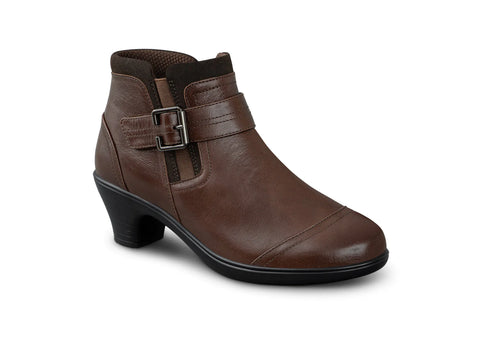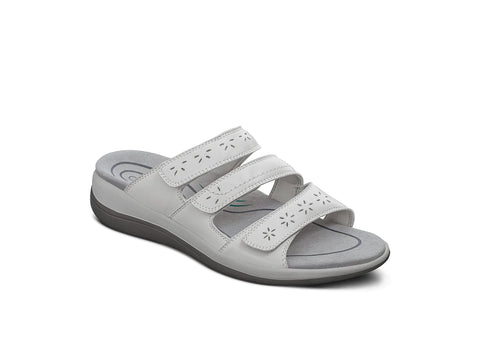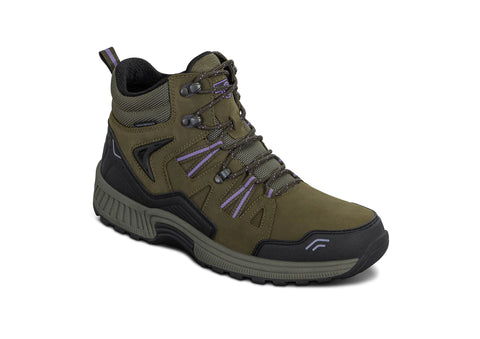Best Extra Wide Shoes for Swollen Feet
Medical information provided by Steven Gershman DPM / Written by OrthoFeet Team on May 03, 2023 Blog HomeAll the shoes on our list have:
- a spacious and comfortable toe box (not including the open toe sandals, naturally) that provides extra space for swollen feet, ensuring that your toes are not cramped or restricted, reducing pressure and discomfort in the affected areas.
- added width and depth that provide a spacious fit for any foot size.
- a heel to toe cushioned outsole that provides excellent support and shock absorption, minimizing pressure on your feet and providing all day comfort.
- a contoured footbed with arch support that provides customized cushioning, as well as a cushioned heel for additional rear-foot support.
- an orthotic-friendly design that allows you to easily insert custom orthotics if needed, and further customize the fit and support provided by the shoes.
Best extra wide dress shoes for swollen feet
Women’s Emma

These booties have a round and deep toe box that provides plenty of room for your toes to spread out. They also have a non-binding design that eliminates pressure points on your feet and accommodates swelling.
Additionally, they have a 2-inch heel that adds height without putting extra pressure on your forefoot, and are made of soft, flexible leather that is padded with foam for a comfortable fit. Plus, they have an adjustable strap that allows you to customize the fit.
Finally, the Emma booties have a medial side zipper that makes it easy to get in and out of them.
Men’s Gramercy

Finding dress shoes that fit well in wider widths without causing foot damage can be a challenge. Luckily, these oxford shoes boast a chic stitch detailing and a lace-up closure that exude both style and comfort and come in wide widths.
The soft and non-binding leather upper material of these shoes offers a spacious fit that alleviates pressure on the feet, and the rubber outsole features an advanced grip, ensuring you remain stable on your feet.
Best extra wide sandals for swollen feet
Women’s Sahara

With no less than three adjustable straps across the instep, the Sahara are one of the best orthopedic sandals for women on the market and are a great choice if you have wide feet.
The soft microfiber uppers have foam padding that protects the feet and improves comfort, and the uppers are soft and can stretch to accommodate swollen feet.
Available in gray, bone and red.
Men’s Gemini

Similar to the women’s Sahara sandals, the Gemini also has three straps, although in this case they are placed in different locations, from heel to toe.
The sandal features two straps that cross the instep and open on both sides, offering a customizable fit. Additionally, the ability to fasten the sandals on either side provides an alternative option for individuals who have difficulty bending down to reach the external part of the shoe. The straps are made with stretch material, allowing them to conform to the shape of your foot.
The third strap is placed at the back of the sandal, allowing you to also adjust the fit in the heel area.
And finally, there is a strap across the toes that opens up completely for anyone with swollen toes or bone deformities.
Best extra wide slippers for swollen feet
Women’s Louise | Men’s Hudson

Your swollen feet can expect to feel exceptionally comfortable in these clog slippers.
With the adjustable closure across the instep you can easily customize the fit, as well as secure it for improved stability.
The soft and flexible uppers hug your feet and conform to their shape and size, and their breathable quality allows airflow and keeps your feet dry and odor free. They also have an antimicrobial lining that promotes foot health and prevents infections.
Finally, the slippers’ durable soles and stylish design allow you to enjoy them even when you step out of the house.
Best extra wide boots for swollen feet
Women’s Dakota | Men’s Ridgewood

If you’re looking for the best boots for men or women, the men’s Ridgewood and women’s Dakota could be the perfect fit, literally, as they are available in a wider than usual range of widths, which is exactly what you need if you have swollen feet.
The high-quality leather uppers are water-sealed and keep your feet dry and allow moisture to escape. Additionally, with the rubber lug outsole, commonly found in sports and work shoes, you can enjoy superior traction and stability on any surface and terrain.
Finally, although they have all the added orthopedic features and look just like regular boots, both boots actually feel surprisingly light on your feet.
Wide Shoes For Swollen Feet
Growing up and now as an adult, I always had trouble finding comfortable shoes.
When I was young, I had no idea shoes had different widths and no shoes ever felt good. Later on, I found shoes with wide width labels and that changed everything. My comfort level improved dramatically.
However, it wasn't until much later in the 1990's that I truly found extra comfortable shoes. What made the difference? SHAPE, what I call the 3rd dimension in shoe fit.
This blog will explain this concept and why extra width and shape are critical to any large foot, and especially those with swelling or deformities.
Edema causes swelling and can often swell the feet significantly. When feet swell, the entire foot can enlarge. I have seen cases in practice of toes that look like sausages from the swelling.
The main area of swelling is usually the top of the foot first, then the width is next, followed by the toes. Thus, fitting shoes becomes an issue. What used to fit before the edema no longer fits and can become impossible to wear.
The foot now requires a wider and deeper shoe with a rounder toe box.
Dimensions of shoe sizing
Shoe sizing generally only includes 2 of the 4 dimensions. It includes length and width.
Some shoe companies still cling to 1 width (medium) fits all. Over the past few years, more companies have finally realized medium width doesn't fit most people, as our bodies have gotten bigger and so have our feet, including width.
I have seen this in my practice as most of my patients now require at least a wide shoe (some need extra wide or more). Very few companies go beyond wide to extra wide, or extra extra wide (6E). Despite this, most companies don't do well beyond these two dimensions.
3rd dimension: shape
A shoe is manufactured on a mold of a foot called the last. The last comes in all the sizes the shoe will be made in, including length and width numbers. The last is the shape of the shoe.
Unfortunately, most lasts just go with the same basic shape as they widen and lengthen the shoe. In many cases, as the foot widens at the arch and ball of the foot, where the width is measured, there is also an enlargement of the forefoot and toes that requires a larger toe box. Thus, in many cases, a wide shoe or even extra wide shoe may not fit well as the toe box is set to fit a narrower foot. In effect, the shoe needs a rounder wider toe box, which is the shape dimension.
The same size 10 (Wide) men’s shoe found in many companies never fit comfortably for me. When I switched to a specialty footwear brand I suddenly felt like I had new feet. WHY? The shape.
The specialty shoes had a much rounder, boxier front or toe box. When I lined up several pairs of other brand shoes with the specialty shoes, I could clearly see the big difference in the shape.
Most other shoes had a narrower pointier toe box. They all felt too tight. My patients are often amazed to see the difference in toe box shape from many shoes to the specialty shoes I wear. They never thought about the shape when purchasing shoes.
4th dimension: depth
There is another aspect to shoe design and fit, and that is depth.
I have many patients with toe deformities who come in with pain from toes rubbing up against the top of the toe box of their shoes.
When I look at the height of the toe box of many shoes, it is quite low. My current pair measures 1 and 3/4 inches high at the toe box. That gives plenty of room for my toes to move and not rub. Many shoes I see in the office measure less than an inch high. There is barely room for the toes.
Extra depth shoes are important. The extra depth is the entire shoe. The heel is deeper, the center of the foot and arch is deeper and, of course, the toe box is wider and higher. This accommodates larger, thicker feet and edema. Also, it is perfect for orthotic insoles giving them room and better stability. Roomier shoes tend to be more comfortable.
Problems with swollen feet
Now that shoe sizing, shape and depth have been covered, we can discuss edema.
As the feet swell, the normal size a person wears will feel too tight. But aside from feeling too tight, other complications can arise.
- The skin will be irritated, potentially causing blisters that can become infected. Infections in feet with edema are dangerous and potentially limb threatening. Swollen feet don't heal well or quickly. Chronic ulcers or sores can develop.
- Deformities, such as bunions and bunionettes (little toe side bunions), rub in the shoe even more with swelling. Hammertoes or other toe deformities also swell and rub in the toe box of many shoes, causing blisters, ulcers or sores, painful corns and jamming of the toes, causing pain.
- Swollen feet tend to bulge out the sides of the normal shoe. The foot is wider so that the regular size can't contain the foot, and the foot pushes out over the sole becoming unstable. This can lead to falls and injuries.
- Another potential issue with swollen feet in poorly fitting shoes is nerve injury. The tight shoe compresses the very superficial nerves on the top of the foot, causing pain or even numbness. At the ball of the foot, between the metatarsals, the nerves going to the toes can be compressed, causing nerve pain, numbness and neuromas. These are thickened nerve coatings that compress the nerves, causing symptoms such as numb toes and pain.
Shoes for swollen feet
What to look for in shoes for swollen feet?
Length: Measure and fit shoes when feet are most swollen, which is later in day. Start with proper length, which is a thumb’s width longer than the longest toe on the largest foot when standing. If your feet are different, go with the larger foot. Also, make sure you are wearing the socks you usually wear, since thicker or thinner socks alter the space in the shoe and make the fit tighter or looser.
Width and depth: When fitting the shoe, again to the larger foot, make sure the foot isn’t bulging at the ball of the foot. If the ball on either side bulges out over the outsole, it is too narrow. The shoe should be comfortable and not feel like it is jammed into the shoe squeezing it. Many people think the heel has to be tight and worry that if it slips up or down a bit when walking, it is too wide. Generally, shoes that fit the wide ball of the foot may be loose at the heel. That is not a major issue, as slightly loose heels are OK. The heel doesn't have to feel welded into the shoe.Fit the rest of the foot and don't worry as much about the heel.
Shape: As written above, the round shape of the toe box is superior for swollen feet and of course, for almost anyone looking for comfort.
Upper material: Another feature to be looking for in severe cases of swollen or very wide, thick feet is shoes with stretchable material. I have used such shoes in practice. In many cases, these were the only shoes that would fit the patient. The knit material stretches and conforms to the contours of your feet and doesn't rub. They are particularly useful with deformed toes and other bony protrusions on the feet.
Adjustability: Specialty shoes enable you to customize and adjust the fit to your particular foot shape. Straps or laces allow you to tighten or loosen the grip in several areas to create a pressure-free fit.
A forefoot strap can accommodate bunions, hammertoes and swollen feet. A heel strap accommodates a wider foot or heel, and laces or a strap across the instep can accommodate swollen, thick, or high instep feet.
Remember, as you age your foot changes. Even without edema, most feet stretch out over the years, becoming longer and wider.
Then, of course, there are the deformities that can occur with age and diseases that change the shape of the feet. What fit once when younger, no longer fits. I have seen patients gain 1 to 2 whole sizes over the years in length and width.
Every year you should check the size and fit of your shoes. If you have swelling, then that should be accommodated immediately. Most people require at least wide shoes as they age and many need extra wide if there are issues.
Don't just go by number, test the shoes for fit and comfort. Shoes should be comfortable. Your feet and health depend on it.
